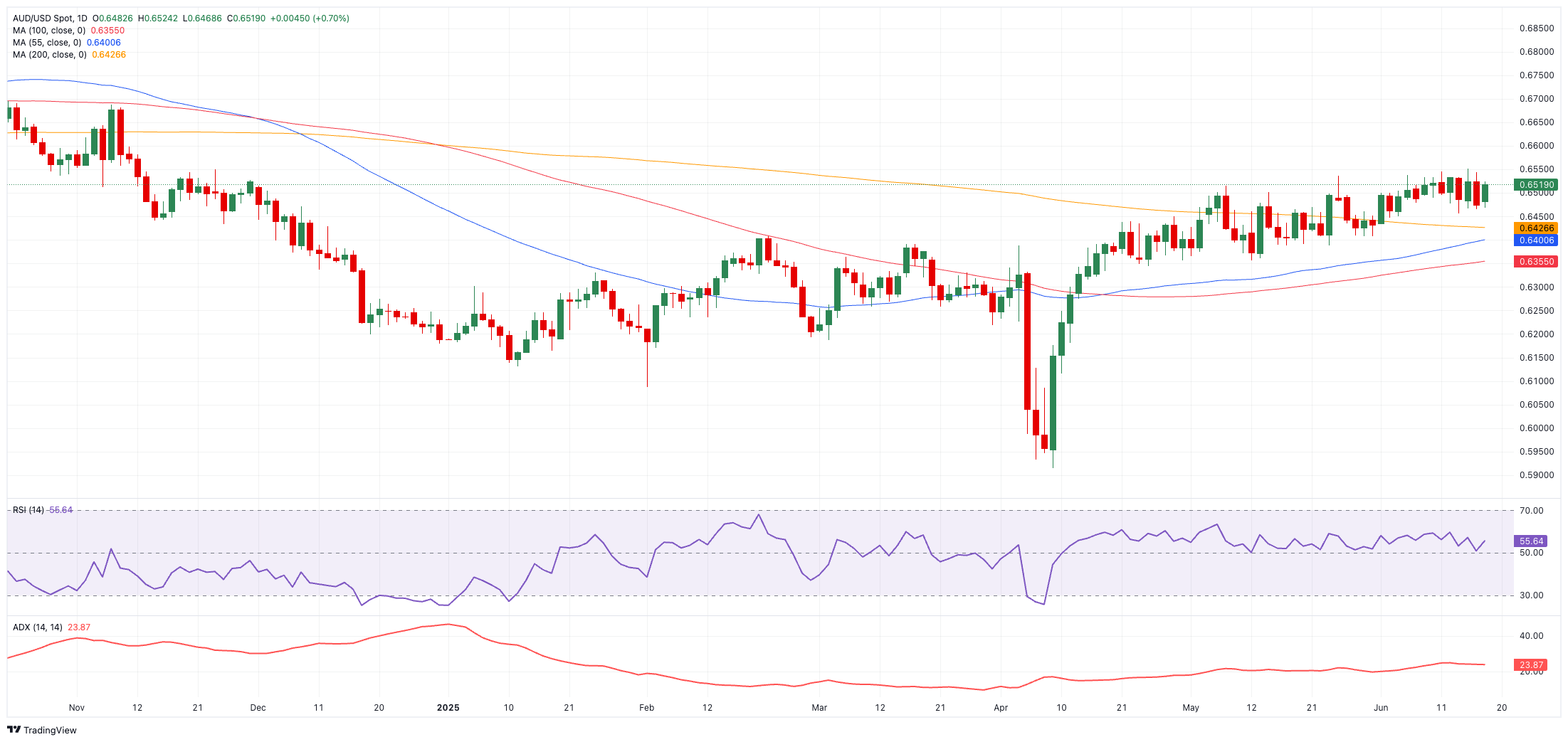
- AUD/USD kept the choppiness well and sound for yet another day.
- The US Dollar traded on the back foot as investors geared up for the Fed.
- The Australian jobs report will be the salient event in Oz on Thursday.
The Australian Dollar (AUD) quickly set aside Tuesday’s strong drop against the US Dollar (USD), prompting AUD/USD to reclaim the 0.6500 hurdle once again, always amid the unchanged consolidative range in place since late April.
So far, the near-term outlook for the Aussie remains tilted to the constructive stance, as long as it trades above the 200-day simple moving average (SMA) around 0.6430.
Central bank policy divide
Investors are weighing the Reserve Bank of Australia’s (RBA) dovish outlook against a more cautious Federal Reserve (Fed).
In its June meeting, the RBA cut its cash rate by 25 basis points to 3.85%, citing easing inflation and slowing GDP growth. Governor Michele Bullock signaled further rate reductions “gradually toward” 3.20% by 2027, tempered by the bank’s readiness to pause if global conditions deteriorate.
By contrast, the Fed is largely expected to maintain its Fed Funds Target Range (FFTR) on Wednesday, with market attention focused on the updated “dots plot” and Chair Jerome Powell’s press conference, even as traders speculate on up to three rate cuts in H2 2025.
China’s lingering headwinds
Australia’s outlook remains clouded by uneven demand from its largest trading partner. May data from Beijing showed improvements in industrial output, retail sales and services activity—supporting an annual economic growth above 5%—but the property sector slump and fading stimulus raise doubts about momentum in the latter part of 2025.
Positioning outlook
Speculative net shorts on the AUD reached their highest since April, according to Commodity Futures Trading Commission data through June 10, supporting the view that a real “game changer” for the currency still need to turn up to at least start changing the traders’ mood toward a more upbeat one.
Technical landscape
AUD/USD faces immediate resistance at YTD top of 0.6551, with a clear break eyeing the November 2024 peak of 0.6687 ahead of the 2024 high of 0.6942 (September 30) and the psychological 0.7000 mark.
On the other hand, initial support lies at the 200-day SMA at 0.6430. If this region is lost, it could potentially lead to a test of the May trough at 0.6356 (May 12).
Indicators remain tilted toward the positive side: The Relative Strength Index (RSI) at nearly 56 points to the likelihood of further gains in the short-term horizon, while the Average Directional Index (ADX) above 26 is indicative of a moderate strength of the trend.
AUD/USD daily chart

Upcoming calendar
Traders will watch Australia’s labour market report on June 19 for fresh signals on the economy, the currency’s trajectory, and its implications for the RBA.
Employment FAQs
Labor market conditions are a key element to assess the health of an economy and thus a key driver for currency valuation. High employment, or low unemployment, has positive implications for consumer spending and thus economic growth, boosting the value of the local currency. Moreover, a very tight labor market – a situation in which there is a shortage of workers to fill open positions – can also have implications on inflation levels and thus monetary policy as low labor supply and high demand leads to higher wages.
The pace at which salaries are growing in an economy is key for policymakers. High wage growth means that households have more money to spend, usually leading to price increases in consumer goods. In contrast to more volatile sources of inflation such as energy prices, wage growth is seen as a key component of underlying and persisting inflation as salary increases are unlikely to be undone. Central banks around the world pay close attention to wage growth data when deciding on monetary policy.
The weight that each central bank assigns to labor market conditions depends on its objectives. Some central banks explicitly have mandates related to the labor market beyond controlling inflation levels. The US Federal Reserve (Fed), for example, has the dual mandate of promoting maximum employment and stable prices. Meanwhile, the European Central Bank’s (ECB) sole mandate is to keep inflation under control. Still, and despite whatever mandates they have, labor market conditions are an important factor for policymakers given its significance as a gauge of the health of the economy and their direct relationship to inflation.
Information on these pages contains forward-looking statements that involve risks and uncertainties. Markets and instruments profiled on this page are for informational purposes only and should not in any way come across as a recommendation to buy or sell in these assets. You should do your own thorough research before making any investment decisions. FXStreet does not in any way guarantee that this information is free from mistakes, errors, or material misstatements. It also does not guarantee that this information is of a timely nature. Investing in Open Markets involves a great deal of risk, including the loss of all or a portion of your investment, as well as emotional distress. All risks, losses and costs associated with investing, including total loss of principal, are your responsibility. The views and opinions expressed in this article are those of the authors and do not necessarily reflect the official policy or position of FXStreet nor its advertisers. The author will not be held responsible for information that is found at the end of links posted on this page.
If not otherwise explicitly mentioned in the body of the article, at the time of writing, the author has no position in any stock mentioned in this article and no business relationship with any company mentioned. The author has not received compensation for writing this article, other than from FXStreet.
FXStreet and the author do not provide personalized recommendations. The author makes no representations as to the accuracy, completeness, or suitability of this information. FXStreet and the author will not be liable for any errors, omissions or any losses, injuries or damages arising from this information and its display or use. Errors and omissions excepted.
The author and FXStreet are not registered investment advisors and nothing in this article is intended to be investment advice.








